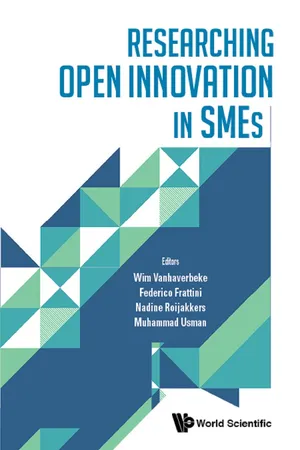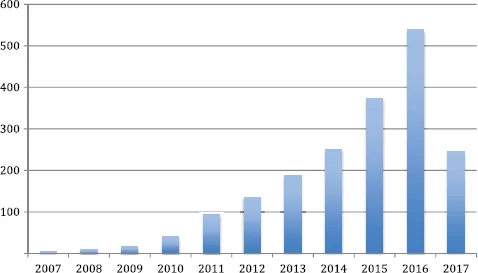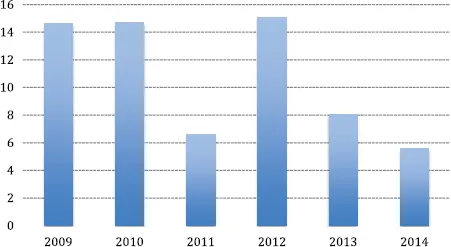
Researching Open Innovation in SMEs
- 536 pages
- English
- ePUB (mobile friendly)
- Available on iOS & Android
Researching Open Innovation in SMEs
About This Book
-->
The concept of open innovation (OI) has become a very popular topic during the last decade, with increasing number of SMEs embracing OI practices to gain competitive advantage. This edited volume is a timely opportunity to gather research on OI in SMEs, to investigate how OI is managed and implemented to determine the peculiarities compared to OI management in large companies, and to specify the consequences for future OI research.
The book offers insights into the following topics: The state of the art on open innovation in SMEs; adopting open innovation in SMEs; interorganizational networks and innovation ecosystems; sectoral patterns of open innovation in SMEs; and measuring, evaluating and stimulating open innovation in SMEs.
--> Contents:
- Introduction (Federico Frattini, Muhammad Usman, Nadine Roijakkers & Wim Vanhaverbeke)
- State of the Art on Open Innovation in SMEs:
- A Systematic Review of the Literature on Open Innovation in SMEs (Muhammad Usman, Nadine Roijakkers, Wim Vanhaverbeke and Federico Frattini)
- The "Hidden Costs" of Open Innovation in SMEs: From Theory to Practice (Cristina Marullo, Alberto Di Minin, Chiara De Eleonora Marco and Andrea Piccaluga)
- Adopting Open Innovation in SMEs:
- An Open Innovation Model for SMEs (Barbara Bigliardi and Francesco Galati)
- Adoption of Open Innovation by Small Firms to Develop Frugal Innovations for Inclusive Development (Mokter Hossain)
- How Do Entrepreneurial Leaders Promote Open Innovation Adoption in Small Firms? (Joon Mo Ahn, Tim Minshall and Letizia Mortara)
- How Do SMEs Use Open Innovation When Developing New Business Models? (Robert William Anderson, Nuran Acur and Jonathan Corney)
- SMEs in Inter-Organizational Networks and Innovation Ecosystems:
- Managing SMEs' Collaboration Across Organizational Boundaries Within a Regional Business Ecosystem (Agnieszka Radziwon and Marcel Bogers)
- Open Innovation Within the Low-Technology SME Sector (Lawrence Dooley and David O'Sullivan)
- Sectoral Patterns of Open Innovation in SMEs:
- Open Innovation Practices of Clustered SMEs: The Intermediate Role of Cluster Governance (Anne Berthinier-Poncet, Simona Grama-Vigouroux and Sana Saidi)
- Exploring Collaborative Practices Between SMEs and Designers in the Italian Furniture Industry (Claudio Dell'Era, Stefano Magistretti and Roberto Verganti)
- The Link Between Entrepreneurial Attributes and SME Ecosystem Orchestration: A Case from the Dutch HR Services Industry (Oana-Maria Pop, Nadine Roijakkers, Diana Rus and Marjolein Hins)
- Crowdfunding of SMEs and Startups: When Open Investing Follows Open Innovation (Giancarlo Giudici and Cristina Rossi Lamastra)
- Measuring, Evaluating and Stimulating Open Innovation in SMEs:
- Measuring Open Innovation in SMEs (Dylan Jones-Evans, Aineias Gkikas, Martin Rhisiart and Niall G MacKenzie)
- The Open Innovation Project Canvas for SMEs (Marc Steen and Wim Vanhaverbeke)
- Open Innovation and Public Policy in the EU with Implications for SMEs (Henry W Chesbrough and Wim Vanhaverbeke)
-->
--> Readership: Undergraduate students, graduate students and researchers in the field of open innovation. -->
Keywords:Open Innovation;SME;Entrepreneur;Innovation Ecosystem;Licensing;Ip;Collaboration;Market Partner;Partnerships;Innovation Management;Business ModelReview: Key Features:
- Systematically addresses open innovation in SMEs
- Introduces specific theoretical frameworks that help us in understanding the specifics of OI in SMEs
- Focuses specifically on the need to integrate open innovation in SMEs with the entrepreneurship literature and the business model (innovation) literature
Frequently asked questions
Information
Chapter 1
A Systematic Review of the Literature on Open Innovation in SMEs
Wim Vanhaverbeke and Federico Frattini
1.1.Introduction
No. | Criteria | Reasons |
Inclusion criteria | ||
1 | Studies focusing on innovative SMEs considering collaboration/strategic alliances/partnerships as a tool or source for innovation | Since the OI phenomenon is new, studies on collaborative innovation, strategic alliances, and partnerships where it leads to innovation for SMEs were also considered |
2 | Studies focusing on OI that consider SMEs as their point of analysis or vice versa | To keep in line with the overall theme of this book |
3 | Theoretical, conceptual, empirical, qualitative, quantitative methodologies, literature reviews | The aim was to include almost all relevant academic publications in this study |
4 | Articles/book chapters published/indexed in Web of Science — Core Collection along with other books published on OI in SMEs | All the main journals and other outlets are indexed in the Web of Science — Core Collection database |
Exclusion criteria | ||
1 | Studies published on related area before year 2003 | OI concept was coined in 2003; so, studies only after 2003 are taken into consideration |
2 | Simple collaboration arrangements | Only studies on collaborations that lead to innovation were considered |
3 | Conference papers, business magazine articles, editorials, or similar publications were not considered | Only journal articles, books, and book chapters were taken into account |
4 | Linguistic expression | Articles published in English were only considered; due to linguistic constraints, publications in other languages were not considered |
1.2.Descriptive and Content Analysis
1.2.1.Descriptive analysis



Table of contents
- Cover
- Halftitle
- Title
- Copyright
- About the Editors
- About the Contributors
- Contents
- Introduction
- Part I State of the Art on Open Innovation in SMEs
- Part II Adopting Open Innovation in SMEs
- Part III SMEs in Inter-organizational Networks and Innovation Ecosystems
- Part IV Sectoral Patterns of Open Innovation in SMEs
- Part V Measuring, Evaluating and Stimulating Open Innovation in SMEs
- Index